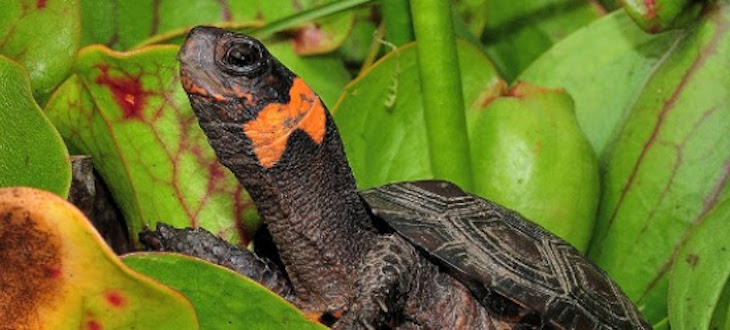The State We're In
Protect New Jersey’s wildlife homes
Visit the Pine Barrens in summer and hear a chorus of Pine Barrens tree frogs, watch northern pine snakes bask in the sun, spot red-headed woodpeckers in the trees or watch bald eagles flying over rivers and reservoirs.
Visit the Highlands and look for bog turtles sunning in marshes, red-shouldered hawks soaring above forested hills, and monarch butterflies. You may even see Acadian hairstreak and Arogos skipper butterflies in wildflower meadows. If you’re especially lucky, you may glimpse an elusive bobcat on the prowl at twilight.
Head down to the Delaware Bay and spot red knot sandpipers feasting on horseshoe crab eggs washed up at the water’s edge, ospreys diving into the surf to catch fish, or even a North Atlantic right whale breaching in the bay.
New Jersey’s wildlife is as diverse as the Garden State’s geography. Mountains, meadows, beaches, coastal plains, rivers, streams, bays and marshes of this state we’re in are home to thousands of species.
But many animals – including those listed above – face an uncertain future due to habitat loss, forest fragmentation, pollution, climate change and competition from invasive species.
More than 80 of New Jersey’s animals are considered endangered or threatened by the state, and dozens more are listed as species of special concern.
Nine of these rare animals are at risk of extinction not only in New Jersey but throughout the United States. Federally endangered New Jersey animals include Indiana bats, northern long-eared bats, red knots, piping plovers, roseate terns, bog turtles, northeastern beach tiger beetles, rusty patched bumble bees and dwarf wedgemussels.
Unfortunately, New Jersey’s wildlife isn’t alone in facing these serious threats.
A recent report by the World Wildlife Fund and Zoological Society of London found that populations of vertebrates – animals with backbones – have declined 60 percent across the planet since 1970 due to human-caused impacts.
According to the 2018 Living Planet Report, we are living through “the Great Acceleration” – a unique event in Earth’s 4.5 billion-year history – with unprecedented changes caused by the ever-increasing human demand for energy, land, water and food.
Threats to wildlife around the world include habitat loss and degradation, industrial scale agriculture, over-fishing, climate change, invasive species and pollution, including plastics in marine environments.
And it’s not only already rare and threatened species that are disappearing. Even backyard species thought common are now declining.
John Cecil, the vice president of stewardship for New Jersey Audubon, said in an interview with NJ.com that the changes are noticeable. “People used to go bird watching and they would encounter many more birds than they would today,” he said.
Insects are also suffering. Beneficial flying insects include native bees, butterflies, moths, ladybugs and fireflies. Some pollinate crops and native plants, while others feed on crop-eating pests like aphids and provide food for birds and bats.
In 2017, a study conducted at 63 nature preserves in Germany found an 82 percent decline in the number and weight of bugs captured in traps in mid-summer, compared with 27 years earlier. Similar studies don’t exist in most places, including New Jersey, because baseline counts of common bugs weren’t done decades ago. But farmers and scientists alike report seeing fewer flying insects than in years past.
How do we halt and reverse the decline of wildlife? One way is to continue preserving land for wildlife habitat, especially rare species. So is defending habitats from emerging threats.
A great local example of taking action is “Bobcat Alley,” a project of The New Jersey Chapter of The Nature Conservancy. They are working to create a corridor of preserved land connecting the Highlands with the Kittatinny Ridge, the easternmost edge of the Appalachian Mountains in New Jersey, to help support habitat for bobcats.
In the state’s Piedmont region, multiple organizations are fighting the proposed PennEast gas pipeline, which would cross western Hunterdon and Mercer counties near the Delaware River. The pipeline would impact thousands of acres of open space and farmland, scores of steep, erodible slopes and pristine streams, and key habitat for rare wildlife, including state-threatened long-tailed salamanders.
In addition to preserving and restoring enough natural land and ocean to sustain all forms of life, the Living Planet Report advocates shifting to clean energy and environmentally-friendly ways to grow food.
“Our day-to-day life, health and livelihoods depend on a healthy planet,” wrote Marco Lambertini, director general of the World Wildlife Fund. “There cannot be a healthy, happy and prosperous future for people on a planet with a destabilized climate, depleted oceans and rivers, degraded land and empty forests, all stripped of biodiversity, the web of life that sustains us all.”
To learn more about New Jersey’s endangered and threatened animals, go to www.nj.gov/dep/fgw/tandespp.htm.
To read the Living Planet Report – either the full report or a summary – go to https://wwf.panda.org/knowledge_hub/all_publications/living_planet_report_2018/.
And to learn more about preserving New Jersey’s land and natural resources, click here or contact me at info@njconservation.org.
About the Authors
Alison Mitchell
Co-Executive Director
John S. Watson, Jr.
Co-Executive Director
Tom Gilbert
Co-Executive Director, 2022-2023
Michele S. Byers
Executive Director, 1999-2021
View their full bios here.
Filter
Get The Latest News
From The Garden State
In the
News

